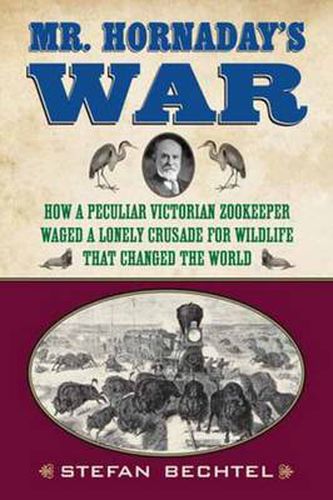Readings Newsletter
Become a Readings Member to make your shopping experience even easier.
Sign in or sign up for free!
You’re not far away from qualifying for FREE standard shipping within Australia
You’ve qualified for FREE standard shipping within Australia
The cart is loading…






He was complex, quirky, pugnacious, and difficult. He seemed to create enemies wherever he went, even among his friends. A fireplug of a man who stood only five feet eight inches in his stocking feet, he began as a taxidermist and an adventurer who tracked tigers in Borneo with friendly headhunters, lead crocodile-hunting expeditions in the Orinoco, and scouted the last remaining bison in the Montana territories.
William Temple Hornaday (1854-1937) was also a man ahead of his time. He was the most influential conservationist of the nineteenth century, second only to his great friend and ally Theodore Roosevelt. When this one-time big-game collector witnessed the wanton destruction of wildlife prevalent in the Victorian era, he experienced an awakening and devoted the rest of his life to protecting our planet’s endangered species. Hornaday founded the National Zoo in Washington, D.C., served for thirty years as director of the renowned Bronx Zoo, and became a fierce defender of wild animals and wild places. He devoted fifty years to fighting gun manufacturers, poachers, scandalously lax game-protection laws, and the vast apathy of the American public. He waged the Plume Wars against the feathered-hat industry and is credited with having saved both the Alaskan fur seal and the American bison from outright extinction.
Mr. Hornaday’s War restores this major figure to his rightful place as one of the giants of the modern conservation movement. But Stefan Bechtel also explores the grinding contradictions of Hornaday’s life. Though he crusaded against the wholesale slaughter of wildlife, he was at one time a trophy hunter, and what happened in 1906 at the Bronx Zoo, when Hornaday displayed an African man in an ethnographic exhibit, shows a side of him that is as baffling as it is repellant. This gripping book takes an honest look at a fascinating, enigmatic man who both represented and transcended his era’s paradoxical approach to wildlife, and who profoundly changed the course of the conservation movement for generations to come.
$9.00 standard shipping within Australia
FREE standard shipping within Australia for orders over $100.00
Express & International shipping calculated at checkout
He was complex, quirky, pugnacious, and difficult. He seemed to create enemies wherever he went, even among his friends. A fireplug of a man who stood only five feet eight inches in his stocking feet, he began as a taxidermist and an adventurer who tracked tigers in Borneo with friendly headhunters, lead crocodile-hunting expeditions in the Orinoco, and scouted the last remaining bison in the Montana territories.
William Temple Hornaday (1854-1937) was also a man ahead of his time. He was the most influential conservationist of the nineteenth century, second only to his great friend and ally Theodore Roosevelt. When this one-time big-game collector witnessed the wanton destruction of wildlife prevalent in the Victorian era, he experienced an awakening and devoted the rest of his life to protecting our planet’s endangered species. Hornaday founded the National Zoo in Washington, D.C., served for thirty years as director of the renowned Bronx Zoo, and became a fierce defender of wild animals and wild places. He devoted fifty years to fighting gun manufacturers, poachers, scandalously lax game-protection laws, and the vast apathy of the American public. He waged the Plume Wars against the feathered-hat industry and is credited with having saved both the Alaskan fur seal and the American bison from outright extinction.
Mr. Hornaday’s War restores this major figure to his rightful place as one of the giants of the modern conservation movement. But Stefan Bechtel also explores the grinding contradictions of Hornaday’s life. Though he crusaded against the wholesale slaughter of wildlife, he was at one time a trophy hunter, and what happened in 1906 at the Bronx Zoo, when Hornaday displayed an African man in an ethnographic exhibit, shows a side of him that is as baffling as it is repellant. This gripping book takes an honest look at a fascinating, enigmatic man who both represented and transcended his era’s paradoxical approach to wildlife, and who profoundly changed the course of the conservation movement for generations to come.